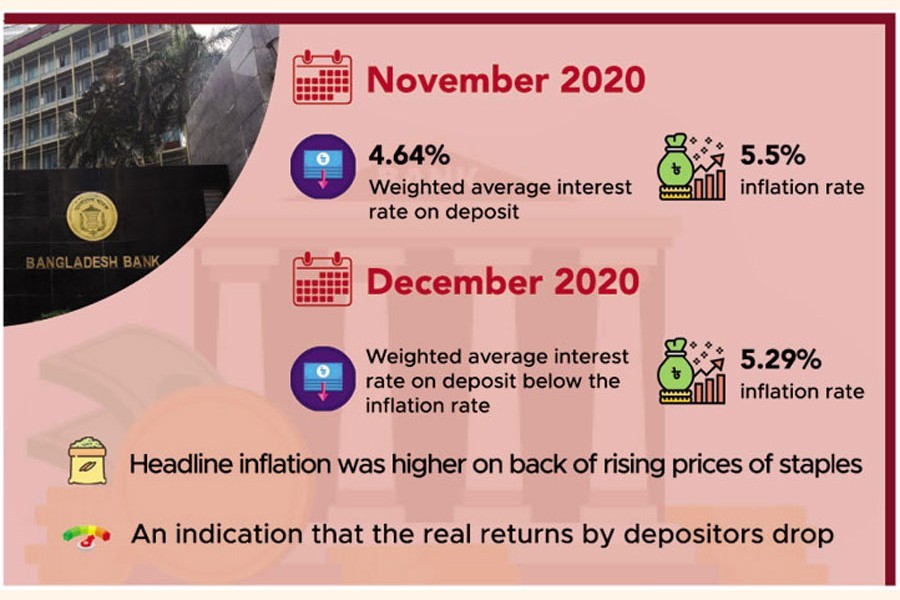
Published :
Updated :

The real rate of return on deposits in the money market had turned negative between the months of April and December last year.
The average rate of interest on bank deposits went below or remained close to the rate of inflation prevailing during the period, according to a latest central bank publication.
In November last year, the weighted average interest rate on deposits stood at 4.64 per cent, lower than 5.5 per cent rate of inflation in the same month, according to the Monetary Policy Review-December 2020 of the Bangladesh Bank.
The rate of inflation, however, dropped to 5.29 per cent in December 2020 but was remained above the weighted average deposit rates.
The headline inflation went up on the back of rising prices of the staples.
Such a situation in an economy means that the real returns for the depositors drop as a result of the higher inflation rates, and it erodes purchasing power significantly.
"The objective of increasing the efficiency in the banking sector through reducing the lending and deposit rates will be difficult to achieve if the rate of inflation is close to or higher than the deposit rate," the publication noted.
During the period under review, the weighted average lending rate also fell to 7.62 per cent in November from 9.58 per cent in March 2020.
However, there are many monetary programmes exceeding the targets in November though set for December 2020.
The Bangladesh Bank (BB) in its report said that it has adopted many strategies, including monetary easing, to keep the money market stable amid the ongoing Covid-19 pandemic.
It cut cash reserve ratio (CRR) by 150 basis points from 5.5 per cent to 4.0 per cent in two phases while reducing the bank rate to 4.0 per cent from 5.0 per cent in July to rationalise the rate with the prevailing interest rate regime.
The central bank, however, issues monetary policy for a full fiscal year with half-yearly programmes for key monetary aggregates.
Net Foreign Asset (NFA) and reserve money grew significantly until November last against the targets set for December 2020.
The growth of NFA more than doubled to 27.75 per cent in November 2020 from the target of 12.48 per cent for December 2020.
This is mainly due to higher purchases of foreign currencies by the central bank from the market.
The growth of reserve money was 20.68 per cent in November 2020, significantly higher than the target set at 15.5 per cent for December 2020.
The BB report observed that it was higher mainly due to the robust growth of net foreign asset of the central bank, resulted from the huge purchase of foreign exchange and net claims of the BB on deposit growth relating to the implementation of the stimulus package.
The net domestic assets remained significantly lower than the target as it stood at 10.29 per cent in November against the December 2020 target of 14.41 per cent. It means that the credit growth to the private sector was much lower than expected.
The private sector credit growth was 8.21 per cent in November last which was projected to grow at 11.5 per cent at the end of December 2020.
The report said the central bank has launched easing of the monetary policy through reduction of the CRR and repo rate to combat the pandemic effect that ultimately helped create huge liquidity in the money market.
It said the total amount of excess liquidity stood at Tk 1,951.7 billion at the end of November 2020. The deposit growth rate also surged to over 13.0 per cent in November last which started showing a falling trend until April-June, 2020 quarter.


 For all latest news, follow The Financial Express Google News channel.
For all latest news, follow The Financial Express Google News channel.